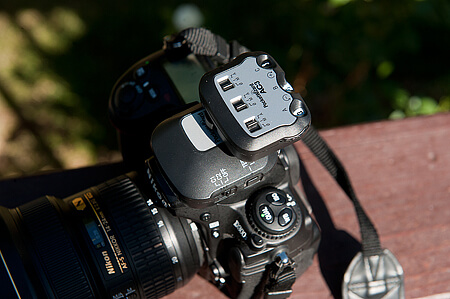 Many of you have been asking is it possible to use high speed sync with the Elinchrom Quadra using Pocket Wizard’s Flex transmitters and Hypersync. The short answer is yes, very much so. The image above was shot using a Quadra with ‘S’ head at 1/2500, F5 at ISO 100. Camera was a D300s, 14-24mm F2.8 lens. MiniTT1 transmitter used, receiver on Quadra was FlexTT5.
Many of you have been asking is it possible to use high speed sync with the Elinchrom Quadra using Pocket Wizard’s Flex transmitters and Hypersync. The short answer is yes, very much so. The image above was shot using a Quadra with ‘S’ head at 1/2500, F5 at ISO 100. Camera was a D300s, 14-24mm F2.8 lens. MiniTT1 transmitter used, receiver on Quadra was FlexTT5.
Here is how the system works. To start I calibrated my miniTT1 transmitter using the Hypersync utility Pocket Wizard provides. I found a setting of -1800 gave me the best results. I saw minimal clipping occurring at 1/1000, and just barely a slice at 1/2500. As I went faster clipping became more apparent. The bottom line here is since I shoot in outdoor environments, clipping is often barely visible at 1/2500, just a tiny band that is easily cropped out (just barely visible in the image above). The scene also affects how visible the clipping will be…dark backgrounds would minimize its appearance.
 In this image, the shot was taken at the same shutter speed, 1/2500, but no clipping is visible because I shot wider and just cropped out the tiny clipped section. I could also shoot slower and further eliminate clipping. Another note, my Quadra was set to around 200 watts, or half power. I imagine I can project flash quite a distance at full power.
In this image, the shot was taken at the same shutter speed, 1/2500, but no clipping is visible because I shot wider and just cropped out the tiny clipped section. I could also shoot slower and further eliminate clipping. Another note, my Quadra was set to around 200 watts, or half power. I imagine I can project flash quite a distance at full power.
 To trigger my Quadra and have Hypersync work required using a FlexTT5 transmitter in receiver mode. The FlexTT5 was connected using a MM1 Pocket Wizard cable. Plug the cable into the flash port (labeled P2 on unit) of the FlexTT5 and plug the other end into the sync port on the Quadra, your ready to go (see picture). You can use a Flextt5 or MiniTT1 on your camera hotshoe.
To trigger my Quadra and have Hypersync work required using a FlexTT5 transmitter in receiver mode. The FlexTT5 was connected using a MM1 Pocket Wizard cable. Plug the cable into the flash port (labeled P2 on unit) of the FlexTT5 and plug the other end into the sync port on the Quadra, your ready to go (see picture). You can use a Flextt5 or MiniTT1 on your camera hotshoe.
The only way this system works is using a ‘S’ head with the Quadra. The slower flash duration allows Hypersync more time to sync shutter and flash burst. I tried an ‘A’ head and couldn’t get it to work…the ‘A’ head has a faster flash duration.
 I have continued to use my D300s and Rangers in high speed sync mode with amazing results. This image was taken at 1/3200 using a ‘S’ Ranger head and MiniTT1 transmitter. The Power ST4 receiver was plugged into the Ranger.
I have continued to use my D300s and Rangers in high speed sync mode with amazing results. This image was taken at 1/3200 using a ‘S’ Ranger head and MiniTT1 transmitter. The Power ST4 receiver was plugged into the Ranger.
 One thing I haven’t mentioned earlier is you can control the Ranger power via the Pocket Wizard AC3 Zone Controller. This fits on top of either your miniTT1 or flexTT5 and adjusts flash output. The ‘0’ setting correlates to 4.5 output on the ranger, and the ‘3’ setting will put your Ranger at 7.5, full power. Having this control at the camera is very handy.
One thing I haven’t mentioned earlier is you can control the Ranger power via the Pocket Wizard AC3 Zone Controller. This fits on top of either your miniTT1 or flexTT5 and adjusts flash output. The ‘0’ setting correlates to 4.5 output on the ranger, and the ‘3’ setting will put your Ranger at 7.5, full power. Having this control at the camera is very handy.
After testing these systems now for weeks, I can’t imagine not having high speed sync with my Elinchrom flash gear. I have shot editorial assignments that I couldn’t have done before, and my mind is spinning with ideas to put the system to extreme tests. Stay tuned!
One last note. Thanks to everyone who has emailed me from around the globe with their own experiences with this system, hopefully this post will address some of the questions asked and suggestions mentioned. I will be speaking at the Manfrotto booth at Photoshop World in Vegas Sept. 7&8 on this topic. If you are there, please come say hello.
UPDATE: Pocket Wizard released a firmware upgrade that should give even better performance. I’ll report back once I get a chance to try the new firmware.